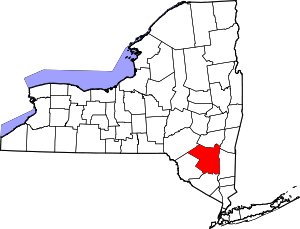Rondout, New York
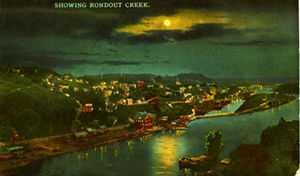
Rondout (pronounced "ron doubt"), is situated on the Hudson, at the mouth of Rondout Creek. Originally a maritime village serving the nearby city of Kingston, New York, Rondout merged with Kingston in 1872. It now includes the Rondout-West Strand Historic District.
History
| New Netherland series | |||
|---|---|---|---|
| Exploration | |||
| Fortifications: | |||
| |||
| Settlements: | |||
| |||
| The Patroon System | |||
| Charter of Freedoms and Exemptions | |||
| Directors of New Netherland: | |||
| |||
| People of New Netherland | |||
| Flushing Remonstrance | |||
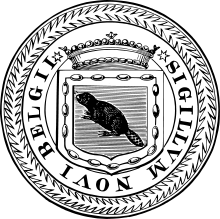 | |||
Rondout borders the Rondout Creek. The creek empties into the Hudson through a large, protected tidal area. Rondout was established by the Dutch in the seventeenth century as an Indian trading post; furs were brought from the inland areas down the Rondout, Walkill and Esopus Creeks and sent by boat down the Hudson River to New York City.
The name derives from the fort, or redoubt, that was erected near the mouth of the creek. The Dutch equivalent of the English word redoubt (meaning a fort or stronghold), is reduyt. In the Dutch records of Wildwyck, however, the spelling used to designate this same fort is invariably Ronduyt during the earliest period, with the present form rondout (often capitalized) appearing as early as November 22, 1666.[1]
The D&H Canal
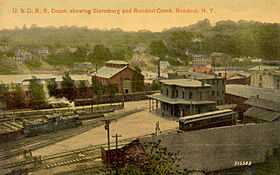
As late as the 1820s, Rondout was a small hamlet. As the Philadelphia coal market was saturated with Lehigh coal, bringing the price down, William and Maurice Wurts developed the Delaware and Hudson Canal as a way to deliver their anthracite from Carbondale, Pennsylvania to New York City. After the opening of the canal in 1828, the area of Rondout rapidly transformed from farmland into a thriving maritime village. The last several miles of the canal, which linked coal mines in northeastern Pennsylvania to the Hudson River and markets beyond, followed Rondout Creek to reach the Hudson River. Irish laborers came to dig the canal and many of them stayed to work on it after its completion. Businessmen established stores to serve the workers. Steamboats, sloops, schooners, and barges loaded with passengers and cargo regularly left the port bound for New York City. New industries developed such as brick and cement manufacturing, bluestone shipping, and ice-making. As canal traffic increased, homes and commercial businesses were built along the slope upward from the Rondout Creek.[2]
By 1840, the village had a population of fifteen hundred, two hundred residences, two churches, six hotels and taverns, twenty-five stores, three freighting establishments, a tobacco factory, a gristmill, four boat yards, two dry docks, and the office and dock of the Delaware and Hudson Canal Company.[3]
Steamboats
Rondout Creek was the home of the Cornell Steamboat Company tugboat fleet, the dominant towing company on the Hudson from 1880 to the 1930s. The company was started in 1847. At one time it had a fleet of as many as sixty-two tugboats towing barges of coal and many other materials on the Hudson River to New York and other ports. Eventually Cornell had a virtual monopoly of towing on the Hudson River and employed hundreds of workers on their boats and in their workshops along the Rondout Creek. By 1872 more than thirty steamboats were based our of Rondout. Many of which, as well as a large number of barges and sailing vessels, were engaged in the transportation of stone, coal, cement, brick, and ice.[4] Steamboats such as the sidewheel "Queen of the River", Kingston's Mary Powell, regularly plied between Rondout, New York and points on the river.

The little sidewheeler Norwich, (160' x 25'3", 255 gross tons), was built in New York in 1836 by Lawrence & Sneeden of New York for the New York and Norwich Steamboat Co. Named for the City of Norwich, Connecticut, she was not big enough to compete with the large steamboats coming into service on the sound, and was sold to the New York & Rondout Line for passenger and freight service on the Hudson. Converted to towboat service, in which she from 1850 to 1923, the Norwich was known as "the Ice King". She was unexcelled as an ice-breaker, opening up the channels in the spring. The Erie Railroad paid her to clear a passage through the ice for its barge and steamboat traffic from the rail terminal at Piermont to New York. Verplanck and Collyer, in Sloops on the Hudson, write that Capt. Jacob Dubois required one week to work the Norwich 20 miles through heavy ice to New York City from Piermont.[5] One of the longest-lived steamboats, the Norwich worked the Hudson until 1917 and survived until 1924.

Prior to its incorporation, Rondout was known variously as "The Strand", "Kingston Landing" and "Bolton". "The Strand" is a Dutch derived reference to the beach once located on the north shore of the Rondout Creek. "Bolton" was used in honor a president of the Delaware and Hudson Canal Company.[6] Incorporated on April 4, 1849, Rondout served as a Hudson River port for the city of Kingston located about a mile distant.
In 1851, a German-born Jewish businessman, Israel Sampson arrived in Rondout and built the Sampson Opera House at 1 Broadway. Sampson ran a successful clothing business out of the first floor, and the top floor housed the Opera House. In 1885, fire gutted the building, destroying the Opera House, which was never rebuilt. In the 20th century, Kingston newspaper, The Daily Freeman, occupied the building until 1974.[7] In 1854 George F. VonBeck built the Mansion House Hotel, hoping to capitalize on Rondout's location as a stopping-off place for steamboat and stagecoach passengers[2] On lower Broadway, it was opposite the Samspon Opera House, and provided a place for touring performers to stay.[8] Dr. Abraham Crispell, who treated patients during the cholera epidemic of 1849 had an office in the Mansion House Hotel.
According to Hamilton Child, the most important manufacturing establishment was The Newark Lime and Cement Manufacturing Company which commenced operation in the spring of 1851. The company owned 250 acres including water front on the channel of the Rondout Creek. The Rondout Manufactory alone produced 227,516 barrels. The works consisted of twenty-one kilns for burning the stone, two mill buildings, four storehouses, capable of storing upwards of 20,000 barrels, a cooperage establishment, millwrights', wheelwrights', blacksmiths', and carpenters' shops, barns stables. Stone from which the Cement was made, was quarried from the hill immediately in the rear of the factory, and was obtained by tunneling and sinking shafts, from which extend galleries in the stratum of cement rock, which inclines to the north-west. An extensive system of railways transported the stone from the quarries to the top of the kilns, where it was burned by being mixed with culm or fine coal, and then passed by a series of descents through the various stages of manufacture till it arrived in barrels at the wharf ready for shipment. As the Cement manufactured often exceeded 1,000 barrels per day, the deficiency in barrels was supplied from the stock accumulated during the season when navigation was closed, and the manufacture of Cement necessarily suspended. The number of men employed varied from 250 to 300.[6]
A steam ferry connected Rondout with the Hudson River Railroad across the river at in Rhinecliff. A trolley connected Rondout with Kingston. It contained ten churches, viz., Methodist, Presbyterian, Baptist, Episcopal, Lutheran, two Roman Catholic and two Jewish; three banks, two newspaper offices, three public schools, several manufactories and about 10,000 inhabitants.[6] That same year it merged with and became a part of the city of Kingston.
The Blizzard of '88
The Blizzard of ‘88 was one of the worst storm to ever strike the eastern seaboard. It started on Sunday morning, March 11, 1888 and the storm continued to rage until Monday midnight. Althoug there was only about two or three feet of snow, gale force winds that reached 60 MPH left snowdrifts as high as 10’ to 20’. During the storm, a rare “blowout tide,” (extreme ebbs caused by strong offshore winds which drain inshore shallows - the opposite of a storm-surge), drained the Rondout Creek enough that boats were grounded on the creek bottom. The ferry boat was hard aground and the Norwich was keeled over to one side. The stage to Ellenville left the Rondout at the usual time but nothing was heard from the stage the next day. The only thing authorities could do was assume that the stage was stuck in the snow someplace and that the passengers were safe. The stage from Ellenville reached Hurley that Monday and stayed until the next day when the driver returned to Rondout with only one sleigh bob.[9]
By the turn of the century it was more efficient and economical to ship coal by rail, and the seasonal canal became obsolete. Portland cement replaced blue stone in building and paving. As less material was shipped the port of Rondout declined.
The Kingston-Port Ewen Suspension Bridge at the foot of Wurts Street was completed in 1921. It crosses the Rondout Creek to link Roundout to Port Ewen. For decades, those who wished to cross the creek had to embark on a chain ferry named the "Skillypot", a derivative of a Dutch word for tortoise.[10]
Prosperity revived briefly with boatbuilding during World War II as three shipyards operated with large work crews building naval vessels.[4]

Construction of the John T. Loughran Bridge over the Esopus Creek required the demolition of a few blocks of the West Strand neighborhood on the north side. This rallied preservationists to get the decaying area designated a historic district. A portion of Rondout's former town center has survived intact and is part of the Rondout-West Strand Historic District.
Events
The City of Kingston holds many festivals in the Rondout neighborhood, including the "Artists' Soapbox Derby". Launched in 1995 by two local artists, Yourij and Nancy Donskoj, the Kingston Artists' Soapbox Derby is an annual event that combining soap box racers and works of art. Spectators can watch these sculptures race down Broadway to the Strand. Prizes are awarded in various categories, including "Most Awkward, Dizzying and Almost Hit a Child".[11]
The "Hooley on the Hudson" is sponsored by the City of Kingston and the Ulster County Ancient Order of Hibernians. According to Jim Carey of the Hibernians, "The Hooley is a traditional celebration after the September harvest, before winter sets in."[12] Held every Labor Day weekend, the parade winds up at T.R. Gallo Memorial Park on the Strand. The Hooley is a festival that includes music, food and craft vendors, and step dancers.
Places of interest
The Rondout Visitor Center is located at #20 Broadway, in the Rondout Waterfront. Rondout is home to a number of art galleries including the Trolley Museum of New York,[13] the Kingston Museum of Contemporary Arts,[14] the Arts Society of Kingston,[15] and Deep Listening Space.
Rondout-West Strand Historic District
The Rondout-West Strand Historic District constitutes the major portion of the extant nineteenth-century village of Rondout. It was added to the National Register of Historic Places in 1979. Due to the decline of business and building activities after the turn of the twentieth century, what remains still displays its nineteenth century character. Although a large eastern portion of the Rondout area was demolished in the recent past, the section remaining illustrates what was a booming trading and industrial community. Though there has been some demolition with the district, the streetscapes generally retain their original mid-to-late nineteenth century integrity.[3]
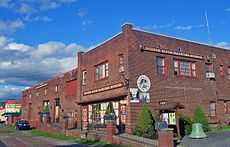
The Hudson River Maritime Museum was founded in 1980 by steamboat and tugboat enthusiasts, as well as local citizens who wanted to preserve the shipping history of the Hudson River. Kingston was also an important stop for passenger steamboats bringing vacationers to the area, many of whom traveled on to the Catskills. It is located at 50 Rondout Landing at the foot of Broadway along Rondout Creek in the city's old waterfront. The Clearwater has its winter home port here and visits frequently as do many historic reproduction vessels such as the Onrust and the Half Moon.
In the summer of 2014 the Irish Cultural Center Hudson Valley was raising funds to complete renovation of the old headquarters of the D&H Canal Corp on Abeel Street into an Irish Cultural Center.[16] According to representatives of the ICCHV, the site is important to the Irish in the Hudson Valley, as the area was once dubbed “Little Dublin” because of the laborers who built the canal and stayed to work on it.[17]
Gallery
-

The Wurts street Bridge (a.k.a. Kingston-Port Ewen Suspension Bridge).
-

A living sculpture made and maintained by a resident artist.
-
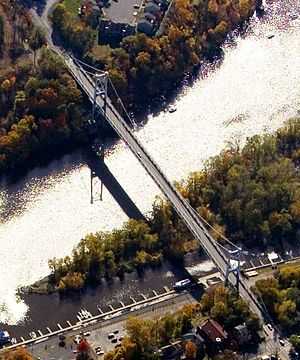
The Wurts Street Bridge from above. (P.Joffe)
-

Kingston point, part of the former town of Rondout, and the trolley.
-
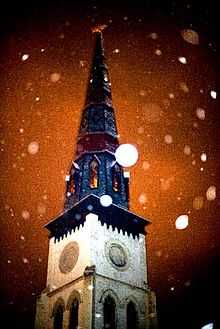
A steeple restored in 2006 on Wurts Street in Rondout.
-
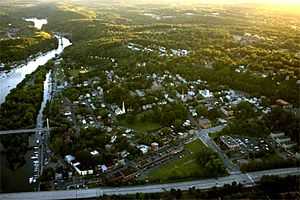
Rondout and Rondout Creek seen from the east (2005).
Coordinates: 41°55′14″N 73°59′06″W / 41.92056°N 73.98500°W
References
- ↑ "Derivation of Place Names".
- ↑ 2.0 2.1 "Rondout-West Strand District", Historic Districts of Kingston, NY
- ↑ 3.0 3.1 Sharp, C. and Sharp, T., HADAC and Larry Gobrect, New York State Office of Parks, Recreation & Historic Preservation, "Rondout-West Strand Historic District, Kingston, Ulster County, New York, nomination document", 1979, National Park Service, National Register of Historic Places, Washington, D.C.
- ↑ 4.0 4.1 "History", Hudson River Maritime Museum
- ↑ Verplanck, Wm. E. and Collyer, Moses W., The Sloops of the Hudson, G.P.Putnam's Sons, New York, 1908
- ↑ 6.0 6.1 6.2 Child, Hamilton. "Rondout", Gazetteer and Business Directory Of Ulster County, N. Y. For 1872-2, Syracuse, New York, 1871
- ↑ "Sampson Opera House", National Park Service
- ↑ "Mansion House", National Park Service
- ↑ "The blizzard of '88", Hurley Heritage Society
- ↑ "Kingston-Port Ewen Suspension Bridge", National Park Service
- ↑ Liu, Pauline. "Artists' Soapbox Derby rolls back into Kingston", Times Herald Record, August 20, 2012
- ↑ Gibbons, Ann. "12th annual Hooley on the Hudson brings flavor of the Irish to Kingston's Rondout neighborhood", Daily Freeman, September 1, 2013
- ↑ Trolley Museum of New York
- ↑ Kingston Museum of Contemporary Arts
- ↑ Arts Society of Kingston
- ↑ Kirby, Paul. "U.S Ambassador to Ireland to be honored at Irish Cultural Center Hudson Valley fundraiser", Daily Freeman, August 24, 2014
- ↑ "The Center", ICCHV
External links
| |||||||||||||||||||||||||||||||||
